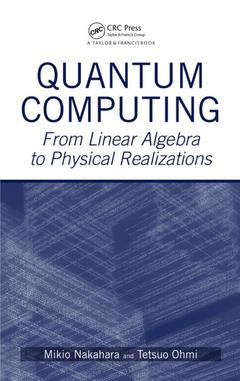Description
Quantum Computing
From Linear Algebra to Physical Realizations
Language: English
Subjects for Quantum Computing:
Keywords
CNOT Gate; cnot; Qubit State; gate; Hadamard Gate; circuit; Quantum Circuit; algorithm; Walsh Hadamard Transformation; hadamard; Rabi Oscillation; divincenzo; Swap Gate; criteria; Bloch Sphere; basis; Hilbert Space; vectors; Quantum Algorithm; qubit; Quantum Gates; Quantum Computer; Density Matrix; Liquid State NMR; Quantum Computing; Quantum Key Distribution; Single Qubit Gates; DiVincenzo Criteria; Charge Qubit; Tensor Product State; Grover’s Search Algorithm; Gate Voltage; Shor’s Factorization Algorithm; Josephson Junction; Optical Dipole Trap
550 p. · 15.6x23.4 cm · Hardback
Description
/li>Contents
/li>Readership
/li>Biography
/li>Comment
/li>
Covering both theory and progressive experiments, Quantum Computing: From Linear Algebra to Physical Realizations explains how and why superposition and entanglement provide the enormous computational power in quantum computing. This self-contained, classroom-tested book is divided into two sections, with the first devoted to the theoretical aspects of quantum computing and the second focused on several candidates of a working quantum computer, evaluating them according to the DiVincenzo criteria.
Topics in Part I
- Linear algebra
- Principles of quantum mechanics
- Qubit and the first application of quantum information processing?quantum key distribution
- Quantum gates
- Simple yet elucidating examples of quantum algorithms
- Quantum circuits that implement integral transforms
- Practical quantum algorithms, including Grover?s database search algorithm and Shor?s factorization algorithm
- The disturbing issue of decoherence
- Important examples of quantum error-correcting codes (QECC)
Topics in Part II
- DiVincenzo criteria, which are the standards a physical system must satisfy to be a candidate as a working quantum computer
- Liquid state NMR, one of the well-understood physical systems
- Ionic and atomic qubits
- Several types of Josephson junction qubits
- The quantum dots realization of qubits
Looking at the ways in which quantum computing can become reality, this book delves into enough theoretical background and experimental research to support a thorough understanding of this promising field.
FROM LINEAR ALGEBRA TO QUANTUM COMPUTING: Basics of Vectors and Matrices. Framework of Quantum Mechanics. Qubits and Quantum Key Distribution. Quantum Gates, Quantum Circuit, and Quantum Computer. Simple Quantum Algorithms. Quantum Integral Transforms. Grover’s Search Algorithm. Shor’s Factorization Algorithm. Decoherence. Quantum Error-Correcting Codes. Physical Realizations of Quantum Computing: DiVincenzo Criteria. NMR Quantum Computer. Trapped Ions. Quantum Computing with Neutral Atoms. Josephson Junction Qubits. Quantum Computing with Quantum Dots. Appendix. Index.



